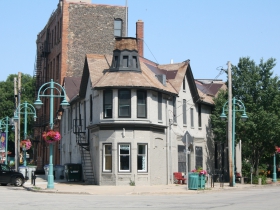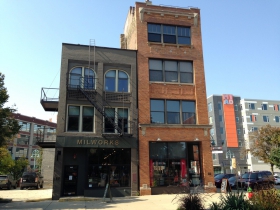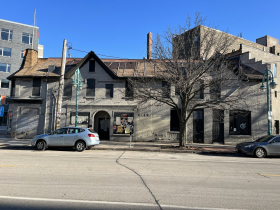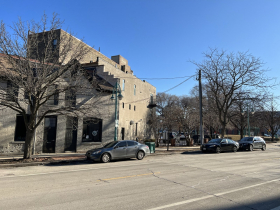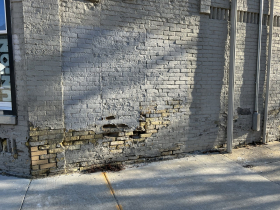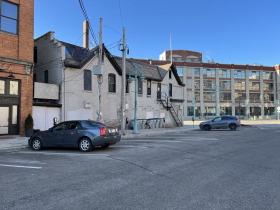Historic Commission Says No To Wrecking Former Wreck Room Tavern
Common Council will decide fate of building, a survivor of 1892 Third Ward fire.
The fate of a Historic Third Ward tavern that survived the neighborhood’s massive 1892 fire now lies in the hands of the Common Council.
The Historic Preservation Commission denied a demolition request Monday evening from General Capital Group and Joseph Property Development, setting up an appeal to the council.
Constructed in 1884, the two-story building at 266-272 E. Erie St. was originally a saloon and rooming house operated by the widowed Catherine Foley. Miller Brewing acquired the property in 1896, using it as a tied-house tavern, and expanded the structure in 1912. It later housed a prominent gay leather bar, Wreck Room, and served as the Milwaukee Institute of Art and Design’s (MIAD) student union. A fire struck in January 2013, shuttering the building.
“From our side of the table, we have to do what’s right from the guidelines,” Commissioner Patti Keating Kahn said when she made a motion to deny the demolition request. “This commission has not been set up to deal with financial implications,” said Commissioner Sally Peltz, referencing the city’s preservation ordinance. The full council can consider economic factors on an appeal and overrule the commission.
The development team’s arguments centered around the cost of any restoration work and the expected “faux replica” result.
“Yes, it can be done, we can rebuild,” said Joseph Property vice president Nathan Bernstein. But he said it would come at a great cost with an effectively new structure resulting. “You have to admit there is subjectivity here.”
“It was well known when we purchased it that it was to be demolished,” said General Capital partner Linda Gorens-Levey. “It is simply not feasible to restore this building.” She said the partners, who purchased the building in 2014 for $760,000, never would have bought it if it was historic. But it was given local historic protection in 2015, which triggers the need for a “certificate of appropriateness” for any demolition or modification.
“We are not disputing the legitimacy of the historic designation,” said Bernstein.
Architect Chris Socha, a partner at The Kubala Washatko Architects, said the issue isn’t truly the 2013 fire, but the nature of the 1912 addition. “These buildings were basically joined together at that time and that’s a principal reason these buildings have so many issues,” said Socha. Structural engineer Alan Rentmeester of Spire Engineering detailed the differing foundation systems each employs, and how one is now leaning on the other, causing a cascading series of issues.
But after more than an hour and a half of debate, their arguments didn’t sway the commissioners. The commissioners sided with a staff report from senior planner Tim Askin, who repeatedly noted the lack of repair work done since the 2013 fire. “There has been no serious effort at interior repair,” said Askin. “They have had over 10 years to address it, and have done nothing.”
Askin said three condemnation requests have been submitted in the past year, but the Department of Neighborhood Services (DNS) has declined to issue an emergency raze order each time. “I’m not accusing anyone of anything, but it concerns me that someone might want to employ the tools of DNS to serve their private interests,” said commissioner and area Alderman Robert Bauman. The development team denied directly making the requests. A DNS official said the department could not disclose who made the requests.
“We have seen worse buildings. It is repairable,” said Askin.
The commission had plenty of its own questions, including why a plan was presented to the Historic Third Ward Architectural Review Board in 2017 to save the building.
“By 2018 we realized there were so many issues here we better pause,” said Socha.
“I am a little confused on how these things were not figured out and they were this far in the process,” said Commissioner Nicholas Hans Robinson, an architect, who detailed that structural calculations would have needed to be done. Socha said permits were sought for work other than the foundation, but that the partners now believe it is the most significant issue.
Bernstein noted that Bauman supported a 2014 demolition-and-replacement proposal. “I reluctantly said, okay, that’s fine,” said Bauman, citing the past quality of the development team’s work, improved financial health for MIAD and the lack of community opposition. But he said once the nomination for historic designation came forward, he changed his mind.
MIAD officials in attendance, including longtime professor Mark Lawson, said the building was already deteriorating in the nearly two decades the school owned the property. “The bricks were disintegrating already,” said Lawson. “The building was decaying.”
Wisconsin LGBTQ History Project founder Don Schwamb sent a letter in support of the development team’s request and also spoke at the meeting. “I don’t want to see this building demolished. However, I am aware there are financial realities,” he said. Schwamb also said the development team had pledged to work with his organization on fundraising.
The commission voted 6-0-1 to deny the demolition request. Matt Jarosz abstained without comment. Jarosz, a UW-Milwaukee architecture professor, serves as the non-voting coordinator for the Historic Third Ward Architectural Review Board. The board would oversee the design of any new building constructed on the site and Jarosz has reviewed the demolition request in his role with the board. One of the public description fields on the otherwise anonymous condemnation requests cites a “Matt” as having submitted the request. “Matt requested raze order be issued for property. He would like inspector to give him a call,” says the June request.
The 2015 historic designation report says the building is the oldest remaining structure in the neighborhood with direct ties to the Irish community, which for several decades was the dominant ethnic group in the area.
The building sits at the triangular intersection of E. Menomonee St. and E. Erie St. For $760,000, the partners acquired the building, the three-story building located to the east at 143 N. Broadway and an adjacent parking lot at 139 N. Broadway in 2014. The four-story building at 147 N. Broadway, divided into condominiums and owned by others, prevents the developers from owning what would otherwise be a triangular site.
The only public comment about what could replace the tavern is the written suggestion of a building that is “sympathetic in scale, integrity, and longevity.”
Photos
Legislation Link - Urban Milwaukee members see direct links to legislation mentioned in this article. Join today
If you think stories like this are important, become a member of Urban Milwaukee and help support real, independent journalism. Plus you get some cool added benefits.
Political Contributions Tracker
Displaying political contributions between people mentioned in this story. Learn more.
- October 13, 2019 - Robert Bauman received $100 from Patti Keating Kahn
- March 23, 2017 - Robert Bauman received $250 from Patti Keating Kahn
- May 10, 2016 - Robert Bauman received $250 from Patti Keating Kahn
Eyes on Milwaukee
-
Church, Cupid Partner On Affordable Housing
 Dec 4th, 2023 by Jeramey Jannene
Dec 4th, 2023 by Jeramey Jannene
-
Downtown Building Sells For Nearly Twice Its Assessed Value
 Nov 12th, 2023 by Jeramey Jannene
Nov 12th, 2023 by Jeramey Jannene
-
Immigration Office Moving To 310W Building
 Oct 25th, 2023 by Jeramey Jannene
Oct 25th, 2023 by Jeramey Jannene



